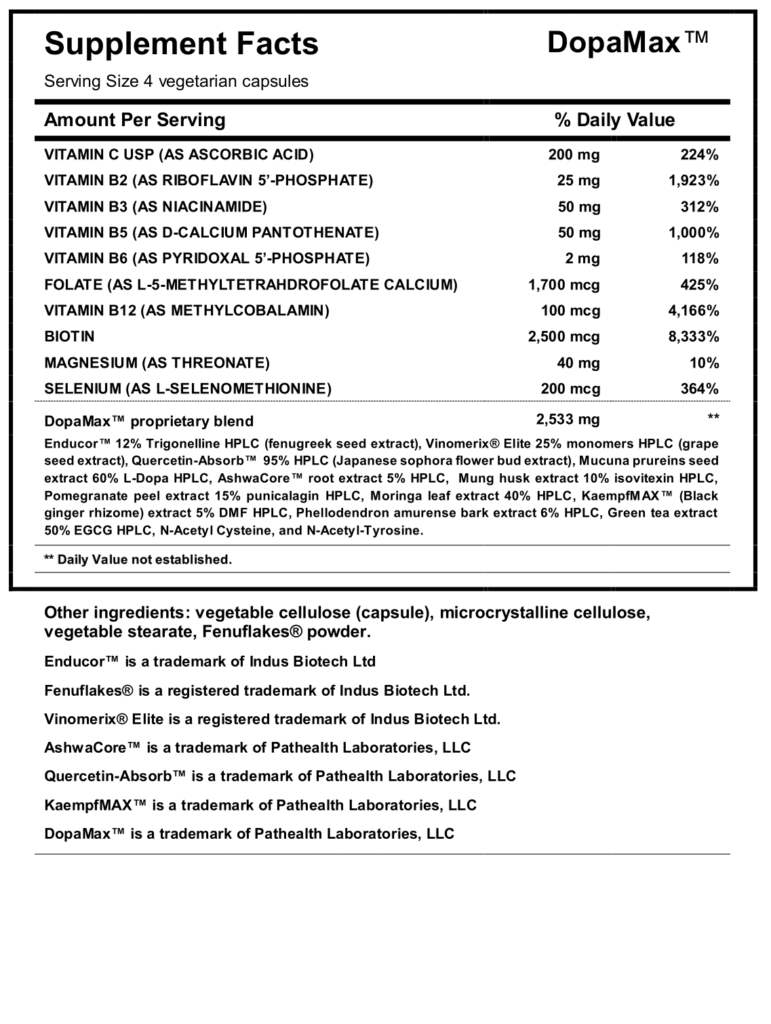DopaMax
TM
Dopamine is a neurotransmitter that promotes feelings of pleasure and reward, supports memory, attention, and more.1
As we age, increased activity of an enzyme called monoamine oxidase B (MAO-B) degrades dopamine, causing levels to fall.2
Lower dopamine levels can contribute to reduced motivation and decreased enthusiasm for things that would excite most people.
A solution is to ingest compounds that inhibit the MAO-B enzyme.
Scientists have found that components of phellodendron tree bark accomplish this in lab studies3,4 and have neuroprotective effects in animals.5-7
Preclinical research also shows that a specific form of vitamin B12 may protect neurons and help prevent a decline in dopamine levels.8
These compounds may help maintain motivation and feelings of pleasure, while reducing risk for neurodegenerative illnesses.
What is Dopamine?
Dopamine is often referred to as the “feel-good hormone” due to its role in regulating mood.1
The brain releases dopamine during pleasurable activities. Low dopamine levels are associated with depression and a lack of motivation and pleasure.9
But the brain uses dopamine for more than mood elevation.
This neurotransmitter also influences movement, learning, cognition, and memory.10
Dopamine enables youthful cognitive performance and body coordination.11,12
Dopamine depletion plays a role in certain neuro-degenerative diseases, while increasing dopamine has been shown to prolong lifespan in animals.1,13,14
In a region of the brain that plays a role in cognitive and motor function, levels of dopamine decline by about 13% each decade after age 45.15
This decline coincides with an increase in the brain levels of monoamine oxidase B (MAO-B), an enzyme that degrades neurotransmitters such as dopamine.2
Low dopamine levels are associated with depression, lack of motivation, and pleasure.9 These mood and motivational changes also may be seen with normal aging in some people.
Rising MAO-B levels pose even more of a threat.
MAO-B activity is higher in dementia patients than in non-impaired individuals the same age,16 suggesting a role in neurodegeneration.
One reason may be that increased MAO-B activity results in formation of potentially damaging by-products2,17,18 that can contribute to neurodegenerative diseases such as Parkinson’ and Alzheimer’s Disease.
Doctors frequently prescribe MAO-B inhibitors such as deprenyl (also called selegiline) to stop MAO-B degradation of dopamine in patients with Parkinson’s disease.19
Inhibiting MAO-B activity helps decrease the breakdown of dopamine and the potential harm that can be done by too much enzyme activity. This helps protect our aging brains.
- Klein MO, Battagello DS, Cardoso AR, et al. Dopamine: Functions, Signaling, and Association with Neurological Diseases. Cell Mol Neurobiol.2019 Jan;39(1):31-59.
- Kumar MJ, Andersen JK. Perspectives on MAO-B in aging and neurological disease: where do we go from here? Mol Neurobiol.2004 Aug;30(1):77-89.
- Mazzio E, Deiab S, Park K, et al. High throughput screening to identify natural human monoamine oxidase B inhibitors. Phytother Res.2013 Jun;27(6):818-28.
- Zarmouh NO, Messeha SS, Elshami FM, et al. Natural Products Screening for the Identification of Selective Monoamine Oxidase-B Inhibitors. European J Med Plants.2016 May;15(1).
- Sun Y, Lenon GB, Yang AWH. Phellodendri Cortex: A Phytochemical, Pharmacological, and Pharmacokinetic Review. Evid Based Complement Alternat Med.2019;2019:7621929.
- Xian YF, Lin ZX, Ip SP, et al. Comparison the neuropreotective effect of Cortex Phellodendri chinensis and Cortex Phellodendri amurensis against beta-amyloid-induced neurotoxicity in PC12 cells. 2013 Jan 15;20(2):187-93.
- Young-Pyo K, In-Chul, J. , & Sang-Ryong, L. Effects of Phellodendron amurense Extract on the Alzheimer’s Disease Model. Journal of Physiology & Pathology in Korean Medicine.2005;19(1):130-8.
- Schaffner A, Li X, Gomez-Llorente Y, et al. Vitamin B12 modulates Parkinson’s disease LRRK2 kinase activity through allosteric regulation and confers neuroprotection. Cell Res.2019 Apr;29(4):313-29.
- Dunlop BW, Nemeroff CB. The role of dopamine in the pathophysiology of depression. Arch Gen Psychiatry.2007 Mar;64(3):327-37.
- Ayano G. Dopamine: Receptors, Functions, Synthesis, Pathways, Locations and Mental Disorders: Review of Literatures. Journal of Mental Disorders and Treatment.2016 01/01;2(2).
- Backman L, Lindenberger U, Li SC, et al. Linking cognitive aging to alterations in dopamine neurotransmitter functioning: recent data and future avenues. Neurosci Biobehav Rev.2010 Apr;34(5):670-7.
- Howe M, Ridouh I, Allegra Mascaro AL, et al. Coordination of rapid cholinergic and dopaminergic signaling in striatum during spontaneous movement. 2019 Mar 28;8.
- Masato A, Plotegher N, Boassa D, et al. Impaired dopamine metabolism in Parkinson’s disease pathogenesis. Mol Neurodegener.2019 Aug 20;14(1):35.
- Knoll J. The striatal dopamine dependency of life span in male rats. Longevity study with (-)deprenyl. Mech Ageing Dev.1988 Dec;46(1-3):237-62.
- Knoll J. Deprenyl (selegiline): the history of its development and pharmacological action. Acta Neurol Scand Suppl.1983;95:57-80.
- Oreland L, Gottfries CG. Brain and brain monoamine oxidase in aging and in dementia of Alzheimer’s type. Prog Neuropsychopharmacol Biol Psychiatry.1986;10(3-5):533-40.
- Finberg JP, Rabey JM. Inhibitors of MAO-A and MAO-B in Psychiatry and Neurology. Front Pharmacol.2016;7:340.
- Naoi M, Maruyama W, Inaba-Hasegawa K. Type A and B monoamine oxidase in age-related neurodegenerative disorders: their distinct roles in neuronal death and survival. Curr Top Med Chem.2012;12(20):2177-88.
- Szoko E, Tabi T, Riederer P, et al. Pharmacological aspects of the neuroprotective effects of irreversible MAO-B inhibitors, selegiline and rasagiline, in Parkinson’s disease. J Neural Transm (Vienna).2018 Nov;125(11):1735-49.

